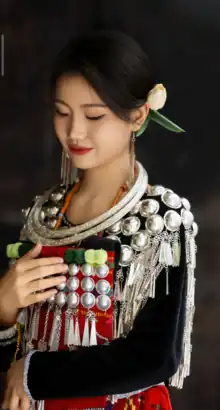ta̠u̠ŋ⁵⁵ ta⁵¹
Pela

ta̠u̠ŋ⁵⁵ ta⁵¹ mi³¹ɣɛ³¹ nɔ³⁵ (Kachin girl)
Etymology
From ta̠u̠ŋ⁵⁵ (“dry field”) + ta³¹ (“child, tribe member”). Compare Zaiwa Dungzo and Lhao Vo taung zo꞉.
Pronunciation
IPA(key): /ta̠u̠ŋ⁵⁵ ta⁵¹/
Noun
ta̠u̠ŋ⁵⁵ ta⁵¹
Usage notes
This term is used to refer to the whole ethnic group of Kachin/Jinghpo, corresponding to Jingpho Wunpong/Wunpawng. The Jingpho tribe in the narrow sense is called pʰauk⁵⁵ va⁵⁵ in Pela.
See also
(Tribes of Kachin):
- pə̆.la⁵⁵ (“Pela people”)
- lə̆.tʃʰɿ³⁵ (“Lachi people”)
- lɔ̠̃⁵⁵ va⁵⁵ (“Lhao Vo people”)
- pʰauk⁵⁵ va⁵⁵ (“Jingpho tribe”)
- ti³¹ ta³¹ (“Jingpho people; (specifically) Zaiwa people”)
- ti³¹ va⁵⁵ (“Jingpho people; (specifically) Zaiwa people”)
(Non-Kachin ethnic groups):
- xɛ⁵⁵ va⁵⁵ (“Han Chinese”)
- sɛ̃³¹ va⁵⁵ (“Tai people; Shan people”)
- mjɛn³¹ (“Burmese”)
References
- Dai Qingxia, Jiang Ying, Kong Zhien, A Study of Pela Language (2007; Publishing House of Minority Nationalities, Beijing)
- Huang Bufan (editor), Xu Shouchun, Chen Jiaying, Wang Huiyin, A Tibeto-Burman Lexicon (1992; Central Minorities University, Beijing)
- Mangshi Jinghpo ethnicity Association of Development and Progress Studies(芒市景颇族发展进步研究学会)(ed.), Han-Zaiwa-Pela Dictionary (汉文载瓦文波拉语对译词典) (2018; Dehong Nationalities Publishing House, Mangshi)
This article is issued from Wiktionary. The text is licensed under Creative Commons - Attribution - Sharealike. Additional terms may apply for the media files.